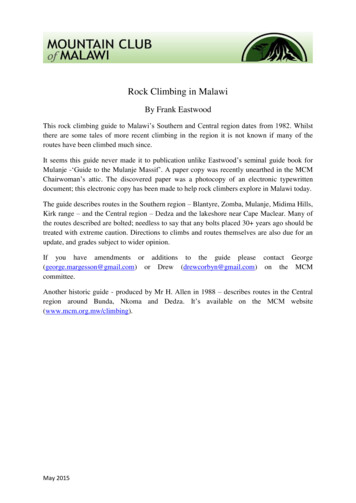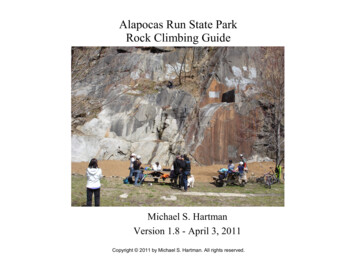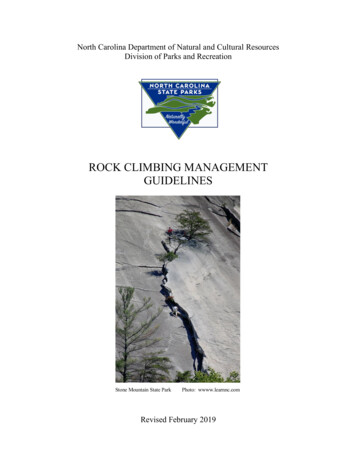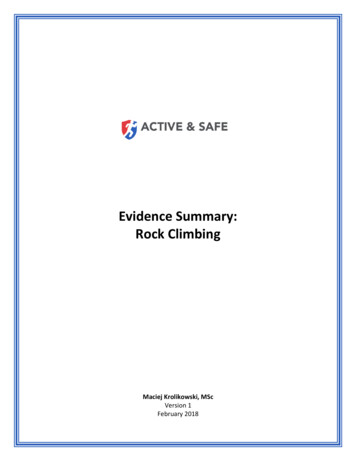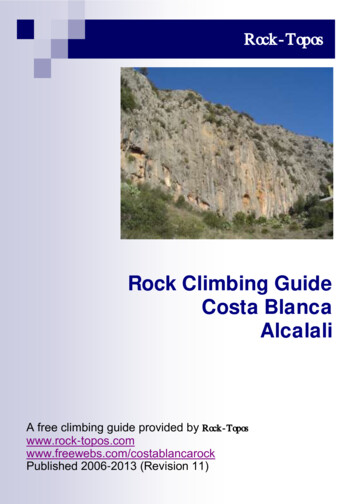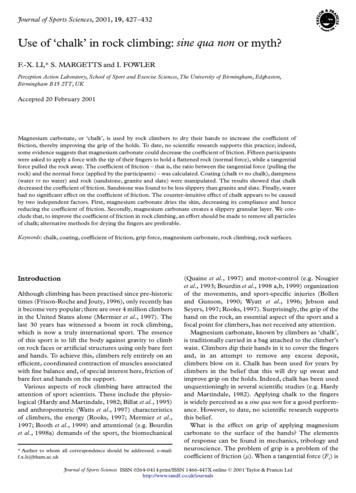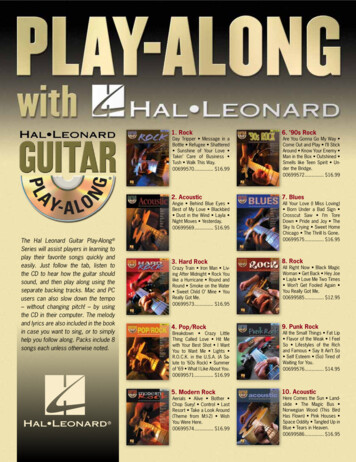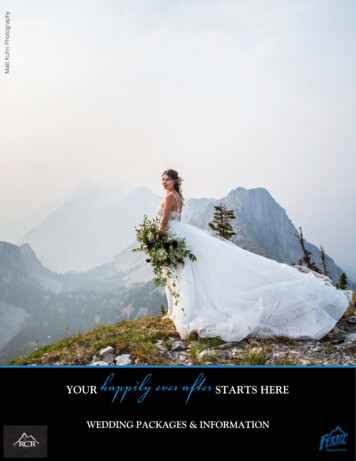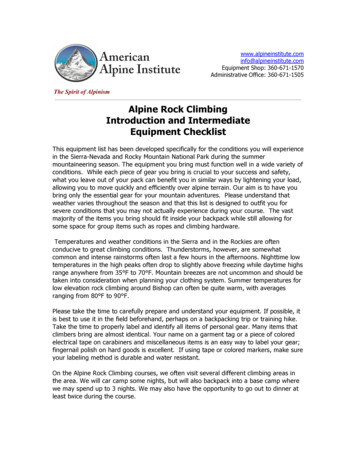
Transcription
The Spirit of e.comEquipment Shop: 360-671-1570Administrative Office: 360-671-1505Alpine Rock ClimbingIntroduction and IntermediateEquipment ChecklistThis equipment list has been developed specifically for the conditions you will experiencein the Sierra-Nevada and Rocky Mountain National Park during the summermountaineering season. The equipment you bring must function well in a wide variety ofconditions. While each piece of gear you bring is crucial to your success and safety,what you leave out of your pack can benefit you in similar ways by lightening your load,allowing you to move quickly and efficiently over alpine terrain. Our aim is to have youbring only the essential gear for your mountain adventures. Please understand thatweather varies throughout the season and that this list is designed to outfit you forsevere conditions that you may not actually experience during your course. The vastmajority of the items you bring should fit inside your backpack while still allowing forsome space for group items such as ropes and climbing hardware.Temperatures and weather conditions in the Sierra and in the Rockies are oftenconducive to great climbing conditions. Thunderstorms, however, are somewhatcommon and intense rainstorms often last a few hours in the afternoons. Nighttime lowtemperatures in the high peaks often drop to slightly above freezing while daytime highsrange anywhere from 35 F to 70 F. Mountain breezes are not uncommon and should betaken into consideration when planning your clothing system. Summer temperatures forlow elevation rock climbing around Bishop can often be quite warm, with averagesranging from 80 F to 90 F.Please take the time to carefully prepare and understand your equipment. If possible, itis best to use it in the field beforehand, perhaps on a backpacking trip or training hike.Take the time to properly label and identify all items of personal gear. Many items thatclimbers bring are almost identical. Your name on a garment tag or a piece of coloredelectrical tape on carabiners and miscellaneous items is an easy way to label your gear;fingernail polish on hard goods is excellent. If using tape or colored markers, make sureyour labeling method is durable and water resistant.On the Alpine Rock Climbing courses, we often visit several different climbing areas inthe area. We will car camp some nights, but will also backpack into a base camp wherewe may spend up to 3 nights. We may also have the opportunity to go out to dinner atleast twice during the course.
When preparing your equipment for travel to California or Colorado, please rememberthat lighters and stove fuel are not allowed on aircraft. Stoves that have beenthoroughly cleaned can be put in your checked baggage. Protect your equipment bycovering your ice axe, crampons, and trekking poles with cardboard or other protectionto prevent the puncturing or tearing of less durable equipment.At AAI we take equipment and its selection seriously. Our Equipment Servicesdepartment is well stocked and its seasoned staff can help guide you through thiscomplex undertaking. Please contact us to select equipment for your course.Equipment items that are available for rental are designated with an (R).Please contact the Equipment Shop at 360-671-1570 for assistance inselecting equipment for your course.Clothing & FootwearBase Layer Top: Bring two. This will be your base layer and should be “lightweight” or“silk weight” synthetic or wool. No cotton. Weight: 5 - 8 oz / 140 - 225 grams Materials: Synthetic, wool. Example: Patagonia Capilene 2Base Layer Bottom: Look for the same features as your Base Layer Top. One pair issufficient. Weight: 5 - 8 oz / 140 - 225 grams Materials: Synthetic, wool.Undergarments: Many climbers wear them underneath their base layer. 1-3 pairsdepending on personal preference for changing. Materials: Synthetic, wool2nd Layer Top: A lightweight fleece or wind shirt. A chest pocket is a helpful feature. Weight: 13 - 16oz / 368-454 grams Materials: Nylon, micro weave fabrics, fleece, wind stopper Examples: Patagonia Houdini, Outdoor Research Marvel, Patagonia R1Soft Shell Jacket: A thin, light, stretchy, breathable but wind and snow-resistant layerthat is comfortable to wear is ideal. This will be your 'action layer' and the outer layerthat you spend the most time in. Hoods are optional but highly recommended. Sizeyour jacket to be trim fitting, but large enough to fit over your base and second layers.Light to moderate insulation/thickness is recommended. This layer will go over yourbase and insulation layers, but under your shell and parka. Weight: 4 – 14 oz / 120 - 400 grams Materials: Schoeller, Powerstretch, Powerdry, or similar Examples: Patagonia Houdini, Outdoor Research Ferrosi, Rab Alpine and ScimitarSoft Shell Pants: Look for the same features as your soft shell jacket. This will beyour outermost layer most of the time for your legs. A thigh pocket is a useful featurefor storing small items. Your base layers need to fit under these pants comfortably.
Weight: 16 - 30oz / 450 – 850 gramsMaterials: Schoeller, Powershield, Powerdry, or similarExamples: Patagonia Guide pants, Black Diamond Alpine Pants, Arc’teryx GammaLT Pants, Mammut ChampShell Jacket: Choose the lightest, most packable, waterproof shell that will still get thejob done. Avoid extra pockets (one or two chest pockets is all you need), 3-layer GoreTex, and hanging linings. Your hood should fit over your climbing helmet. Your shellshould be sized to comfortably fit over your other base and mid-layers (minus yourinsulating layer). Weight: 8 - 20oz / 227 – 566 grams Materials: eVent, Gore-tex, h2No, or similar Examples: Rab Latok Alpine, Patagonia Jetstream, Marmot PrecipShell Pants: Made of a waterproof/breathable material, your lightweight shell bottomsshould have full or hip-length side zips. This garment should be extremely lightweightand packable. A zipper fly is a nice optional luxury. Weight: 8 - 16oz / 227 – 453 grams Materials: eVent, Gore-tex, h2No, or similarLight Insulating Layer: The goal for this piece is to add warmth to your internallayering system. Depending on your clothing system and the environment you are in,you may fit this layer underneath your shell gear (e.g. fleece sweaters) or over yourshell gear (lightweight insulated jackets). If choosing fleece, pick modern fleecegarments with waffle-grid patterns and avoid “windproof fleece” as it is not breathableenough. The weight and design of this piece will vary based on the other items ofclothing that you bring. Weight: 10 – 14opz / 280 – 400 grams Fill Materials: Primaloft, Down Examples: Patagonia Nano Puff or Nano Air Hoody, Rab Microlight Alpine,Arc’Teryx Atom LT Hoody, OR Cathode HoodyMid-weight Insulation Jacket: This should only be included for programs that startprior to June 10. A warm puffy jacket with an optional hood. These come in manyshapes, sizes and temperature ratings and are often called “belay jackets.” If you tendto get cold easily, opt for a slightly warmer and more substantial parka. Weight: 20 - 40oz / 566 – 1133 grams Fill Materials: Primaloft, down Shell Materials: nylon, epic, eVent Examples: Patagonia DAS Parka, Montbell Flatiron ParkaMid-weight Fleece/Schoeller/Leather Gloves: The most desirable glove is onethat is comfortable and dexterous, so that it can be worn all day. It should be durableenough (leather palms) to handle ropes, ice axes, and a bit of rock scrambling. Choose amid-weight model. Weight: 4 – 8 oz / 110 – 200 grams Materials: softshell, windstopper fleece, leather or similar
Shell Gloves: These are only required in May. A waterproof shell sized to fit over yourliner gloves, these will be worn during any cold/stormy weather and need to bedexterous enough to manipulate carabiners, harnesses, and tie knots. The highestpriority with these gloves is to keep your hands and liner gloves dry. No mittensallowed. Weight: 6 – 10 oz / 170 - 280 grams Shell Materials: Gore-tex, Schoeller 3x, or similarBeanie Hat/Toque: Bring a warm hat that will fit under your climbing helmet. Weight: 2 – 4oz / 56 – 112 grams Materials: fleece, wool, windstopper, or similarSun hat: A baseball cap or visor serves well. Models with a “tail” provide increased sunprotection.Socks: Bring two or three complete changes. Adjust your sock system ahead of time toperfect your boot fit. No cotton. Materials: wool, syntheticApproach Shoes: Bring a pair of tennis shoes or “approach shoes” for use in campand for approaches with no snow. Sticky rubber approach shoes can be extremelyvaluable on “easier” climbs where rock shoes might feel like overkill. Examples: La Sportiva Cirque Pro, Five.Ten Five TenniesLightweight Mountaineering Boots for snow and ice: Lightweight leather orsynthetic mountaineering boots are ideal. These must have at least a ½ length shankand be designed for use with crampons. Look for a model with a waterproof/breathableliner to help keep your feet dry. Examples: Kayland Apex Rock, La Sportiva Trango S, Garmont Tower GTXNOTE: There are many of makes and models out there and not all are created equal.Please consult with our Equipment Shop if you are uncertain about the acceptability ofyour chosen model.Climbing EquipmentCarabiners: Bring four total. Two must be large, pear shaped (or Münter) lockingcarabiners. Wiregate non-locking carabiners work well for the remaining two.Climbing Harness: (R) For alpine climbing, choose a harness with adjustable leg loopsand a belay loop. Make sure it fits your body when wearing bulky clothing. Gear loopsare desirable. Weight: 6 - 16oz / 170 - 453 grams Examples: Black Diamond Blizzard, Arc’Teryx A300aClimbing Helmet: (R) Lightweight, well ventilated, and comfortable. Models with aplastic shell are more durable, but are heavier than all-foam models. Must be UIAAapproved for climbing. Examples: Petzl Elios, Black Diamond Half Dome
Ice Axe: (R) We recommend using an axe that is about 50cm. For many courses andascents, there are days when the axe will be used only briefly, and spend most of theday strapped to the pack while you are climbing rock.Steel Crampons: (R) Flexible or semi-flexible. New-matic crampons are the easiest toput on with cold fingers. Only modern strap on, step-in, or ‘new-matic’ crampons areacceptable. Older Scottish style strap-on crampons are not adequate. Examples: Petzl Irvis, Black Diamond Contact Strap, Grivel G12NOTE: Check with the office to ensure that you need an ice axe and crampons. Lateseason (August-September) programs may not require these items.Belay Device: Please bring an autoblocking belay device that is designed for belayingmultiple ropes on multi-pitch climbs. Examples: Black Diamond ATC-Guide, Petzl Reverso 3Rock Shoes: An ‘all around’ rock shoe is recommended. Size them to fit comfortably.Trekking Poles: (R) At least one is required and two are recommended. Even if youdon’t normally use trekking poles, at least one is necessary to help with balance whilecarrying heavy packs on mountainous terrain and crossing streams.Optional Additional Climbing Equipment: Those who participate in theIntermediate program may wish to use some of their own climbing equipment. If youwish to do so, you may bring your own cams, stoppers, etc.Camping EquipmentTent: (R) A lightweight 3-season two-person tent is recommended. It should be able towithstand short, but intense rain storms. Single-wall models are lighter, but suffer frommore condensation than heavier double wall models. Generally, your shelter shouldweigh no more than 3 lbs. per person. Weight: 3.5 – 5.5lbs / 1.6 – 2.5 kgSleeping Bag: Rated to around 20 F from late June to mid-September. Bring a 15 to20 for early and late season trips. Down is preferred. To help keep your sleeping bagdry, bring an extra large garbage bag with which you can line your sleeping bag stuffsack and use for storage in the tent. Weight: 16 – 42 oz / 453 – 1200 grams Materials: Down, Primaloft, Polarguard 3DCompression Stuff Sack: Used to shrink your sleeping bag into the smallest sizepossible. Weight: 2-4 oz / 56 – 110 grams Materials: SilNylon, eVent, or similar
Sleeping Pad: You will likely camp on both snow and dirt during this course. Pleasebring a patch kit for inflatable pads. Weight: 8-20 oz / 225 – 565 grams Example: Thermarest Neo Air, Exped Down MatInternal Frame Pack: 40-60 Liters is ideal. This needs to be a climbing pack, not abackpacking pack. Climbing packs have minimal suspension and parts that areremovable, such as a removable lid and no extra zippers or straps. Weight: 3.0lbs / 1.6kg Examples: Black Diamond Speed 40 or 55, Arc’Teryx Alpha FL 45, Cold ColdWorld Valdez, CiloGear 40L Worksack, Gregory Alpinisto 50Stove: (R) Liquid fuel or canister stoves are acceptable. We'll likely pair up on stoves atthe Rendezvous to save weight. Examples: MSR Whisperlite, Jetboil, MSR ReactorFuel: White gas or gas canister. 22oz of white gas or two 8oz canisters are usuallysufficient. Fuel is available to purchase at the rendezvous for your course.Fuel Bottle: (R) For use with liquid fuel stoves. Leak-proof bottles designed for yourspecific stove such as Sigg or MSR are best.Pots: One 1½ - 2 quart pot is enough for one person. Two people sharing a stovemight want to bring two pots if their meals are significantly different. Materials: Titanium, aluminumEating Utensils: Spoon: Bigger is better. Lexan is lighter, but metals spoons are more durable. Thermal mug: 16-20oz with a lid. Optional. You may be able to use a waterbottle for this purpose. Bowl: A lightweight Tupperware-type bowl is recommended. The new, ultra-lightfolding plastic contraptions are excellent. Avoid metal bowls, they are expensive,and make your food get cold very fast (or burn your hands when you are eatingsoup). You may also be able to use your pot for this purpose.Lighter: Bring two. Lighters are no longer acceptable in checked baggage when flying.Hydration: 3 liters of water capacity minimum. Hydration bladders with a hose arerecommended.Water Purification: Bring tablets or liquid purification. Filters are overly heavy andshould not be used. Examples: Aqua Mira, Potable AquaFood: You are responsible for planning your meals for the duration of this program.Please have a few days of car camping food and four days of food ready to be carriedinto the mountains. Food and clothing that is not needed in one area can be left in your
vehicle. We have included meal planning guidelines in your program packet. Please callour office for additional guidance in the food planning and packing process.Personal Medical Kit:Please include duct tape, moleskin, bandaids, blister caresupplies, and prescriptions at a minimum.Personal Toiletries: Bring a toothbrush, toothpaste, floss, etc. Bring half a roll oftoilet paper or less. Travel sized containers are excellent.Hand Sanitizer: Any alcohol based product for hand sanitizing work well.Sunscreen: With SPF 30 or higher. A couple of 1 oz. tubes are adequate. Several smallcontainers are better than one large one.Lip Protection: Bring 2 containers/applicators with the highest SPF available. Somemodels of chapstick have SPF15 or higher.Glacier Glasses / Sunglasses: Choose a model with 100% UVA/UVB protection. Ifyou have an extra pair, bring them too. Those using contact lenses should bring a pairof prescription glasses if available.Garbage Bags: Bring two or three large ones to line your backpack and to pack outgarbage. Trash compactor bag, if available, are more durable.Headlamp: High output LED models are preferred over older halogen models. Bringone set of extra batteries. Flashlights are not acceptable. Examples: Petzl Tikka XP, Black Diamond SpotRepair Kit: At a minimum this kit should include a stove repair kit for your stove,Thermarest repair kit (for Thermarest pad users), 10 to 20 feet of lightweight nyloncord, small sewing kit, duct tape (wrapped on water bottles or trekking poles), and apack waist buckle.Multitool: Bring one of you have one. Any multitool similar to a Leatherman is great.One can be shared amongst tent-mates.Optional EquipmentThe items listed below are not required, although many are nice “luxury” items that canmake your course more enjoyable. Remember that a few ounces here and there add upto extra pounds on your back and knees during your course.Handiwipes/Wet Wipes: The mountain shower. For personal hygiene and generaluse.Bandana: A cotton bandana has many uses on the mountain.Pee Bottle: A nice luxury for those cold nights. 1-quart size minimum. A collapsible 2LNalgene is recommended. If you choose to bring one of these, use it carefully and
make sure the capacity is adequate. Label your pee bottle well. Women should alsobring a pee funnel; Freshette makes a tried and true model.Entertainment: Books, cards, are great for evenings in the tent. iPods are popular.Ear Plugs: Defense against snoring and high winds in the area.Camera: We recommend a small point-and-shoot cameras that can easily be carried inan outside pocket or small case outside your pack. If you can’t comfortably and safelycarry your camera outside your pack, even in bad weather, you’ll miss the best photoopportunities. Though some climbers bring them, SLR cameras are not recommendedbecause of weight and bulk. If bringing a digital camera, consider your battery needs.Compass: A liquid-filled model for basic map and compass navigation is appropriate.Models with adjustable declination are desirable as they make map work easier.Climbing Backpack: A small (16-40L) backpack is a great option for climbing multipitch rock climbs or as a summit pack in the mountains. Examples: Black Diamond Bullet, Cilogear 20L Worksack, Grivel Air Tech 28T-shirt: Light colors are best. This shirt can be synthetic or cotton. If you plan to hikein it, synthetic is better. A cotton shirt can be a nice break from the synthetics while atcamp.Shorts: Lightweight shorts are nice for warm days. Weight: 4 - 8oz / 110 - 227 grams Materials: NylonBuff: Buffs are a multifunctional neck gaiter that can substitute for a lightweightbalaclava.Foot Powder: A very small bottle will allow you to treat your feet daily, keep themdryer, extend the life of your socks, and help you avoid blisters/rashes from chronic wetfeet. Weight: 1 - 2oz / 28 – 56 grams Examples: Gold Bond, Dr. SchollsComfortable Clothing: Bring a set or two of comfortable clothing for use while carcamping.Sandals/Flip flops: These are great for relaxing in camp in the evenings.Shower Supplies: Often, but not always, pay showers can be taken during thecourse. Bring a towel, shampoo, and quarters for this potential luxury. This will be leftin your vehicle during the course.Post-Climbing Clothing: A clean set of clothing is an excellent item to leave in thevehicle to change into upon your return.
The Equipment Shop at the American Alpine InstituteThe Equipment Shop at the American Alpine Institute provides clothing and equipmentfor purchase, rental gear, and advice. Shop staff members are great climbersthemselves and deeply involved in evaluating and testing gear. They are considered bymany outdoor gear manufacturers to be the most expert in the country. Theythoroughly understand the needs of climbers who will be rock climbing, ice climbing,mountaineering, or exploring the world on international expeditions.Please consider our staff members a part of your resource team in preparing for yourtrip. AAI Equipment Specialists are on hand to consult with you on specific gear needs,to answer questions on the latest equipment and innovations, and to makerecommendations on best choices of clothing and equipment. They can assure that youare equipped with the best possible gear for your climbs. And if you have any difficultydetermining if some particular items of clothing or equipment you already own will serveyou well on a particular trip, they can help you answer that question.Guides Choice International Field TestingThe Equipment Shop at the American Alpine Institute also administers AAI’s prestigiousGuide’s Choice Award. Equipment and clothing that have been awarded the GuidesChoice designation have proven to be the top item in their product category. Theawards are made on the basis of excellence in design, performance, and durabilitydemonstrated in rigorous international field tests carried out by the professional guidesof the Institute. All of the products at the Equipment Shop and on the website havebeen field-tested or have been vetted and are in the process of being field-tested.Call or E-mail the Equipment Shop for Advice or GearPlease feel free to contact us and to let us help you get ready for your climbing trip.Our staff members are experts in the field, and the items of gear that we rent and sellare the best made in terms of design, performance, and durability. Your comfort andsafety depend on being well equipped. Whether you get your gear from us or just getadvice, we’re hear to help you prepare.Call: (360) 671-1570Email: info@alpineinstitute.comEquipment Shop Website: www.alpineinstitute.com
low elevation rock climbing around Bishop can often be quite warm, with averages ranging from 80 F to 90 F. Please take the time to carefully prepare and understand your equipment. If possible, it is best to use it in the field be
